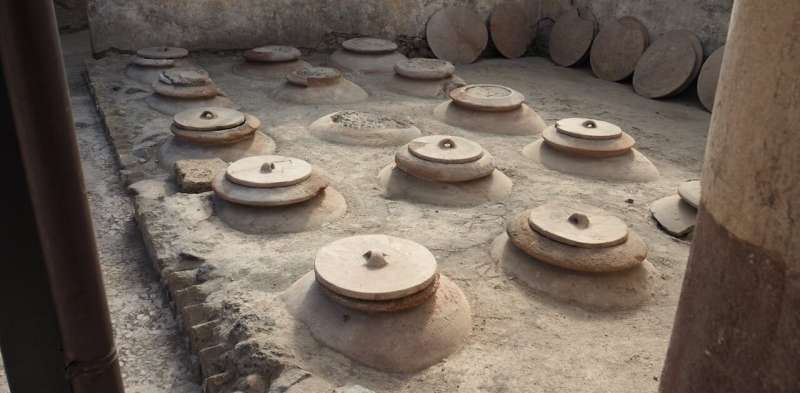
The dolia defossa wine cellar of Villa Regina (Boscoreale). Emlyn Dodd. Credit: Ministero della Cultura – Parco Archaeologico di Pompei
From a modern, scientific perspective, the wine Romans drank is often seen as an inconsistent, poorly made and thoroughly unpleasant beverage. It is alleged that Roman winemakers had to mask their products’ flaws by adding spices, herbs and other ingredients to the freshly pressed grape juice, which is known as “must.”
However, our research has shown this may not have been the case: A recent study of earthenware vessels used in wine fermentation—both ancient and contemporary —has challenged traditional views on the taste and quality of Roman wine, some of which may even have rivaled the fine wines of today.
Many of the longstanding misconceptions surrounding Roman wine come from a lack of insight into one of the most characteristic features of Roman winemaking: fermentation in clay jars or dolia. Huge wine cellars filled with hundreds of these vessels have been found all over the Roman world, but until we began our study no one had looked closely at their role in ancient wine production.
In our research, we compared Roman dolia with traditional Georgian production vessels, called qvevri, which are still in use today. This traditional process was given protected status by UNESCO in 2013, and the similarities between Georgian and Roman winemaking procedures, along with archaeology and ancient texts, point to wines with comparable tastes and aromas. The results of our study were published in January 2024 in the journal Antiquity.
Porous eggs buried in the ground
Unlike the metal or concrete containers used in modern winemaking, clay jars are porous, meaning the wine is exposed to air during fermentation. This contact, however, is limited by coating the interior of the vessels with an impermeable substance. The Romans used pitch from pine resin, while nowadays, in Georgia, neutral beeswax is applied. This controlled air contact makes for great wines, typically with grassy, nutty and dried fruit flavors.
The shape of the vessel is also important. Its rounded, egg-like form causes the fermenting must to move around, which in turn leads to more balanced and rich wines. At the same time, its narrow base prevents grape solids that sink to the bottom from having too much contact with the maturing wine, keeping harsh and unpleasant flavors from appearing.
By burying the vessels in the ground, winemakers can control temperature and provide a stable environment for wine to ferment and mature during its many months inside the jars. Temperatures in modern qvevri commonly range from 13° C to 28°C. This is ideal for malolactic fermentation, which turns sharp malic acids into softer lactic acids, often giving today’s white wines macerated in clay jars caramel and nutty tones.
Macerated wines
Modern wine is typically grouped into whites, rosés and reds. To produce these styles, whites get little or no contact with the grape skins, while rosés get just enough to receive a soft pinkish color. Longer macerations are reserved for reds.
In clay jar winemaking, however, white wines regularly undergo long macerations with the grape solids (skins, seeds, and so on). This gives beautiful dark yellow, amber colored wines, today commonly known as “orange wines”. This wine—increasingly popular today—is similar to descriptions of some of the most prized wines in antiquity.
Protective yeast: the miracle of flor
Buried clay jars encourage the formation of yeasts on the surface of the fermenting must. Many of these are what we call “flor” yeasts, a thick white foam layer that protects the wine from contact with the air. Ancient Greek and Roman texts are filled with descriptions of such surface yeasts in wines.
Flor produces several chemicals, including sotolon, which gives wine a spicy taste. It also gives aromas of toasted bread, apples, roasted nuts and curry. This is a sensory profile quite comparable with the herb fenugreek, which the Romans often added to grape must to strengthen this desirable flavor.
Roman wines revisited
Evidently, the Romans were well aware of many different techniques to master and alter the qualities of their wines. By varying the size, shape and the position of dolia, Roman winemakers were able to have great control over the end product, as Georgian winemakers do today.
Our research emphasizes the value of comparing ancient and modern wine production techniques. It not only debunks the alleged amateurish nature of Roman winemaking, but it also uncovers common traits in millennia-old winemaking techniques.
In some parts of Europe today, including France and Italy, modern winemakers are reviving these ancient methods to produce “new” clay jar wines. While such wines are often mistakenly termed “amphora wines” (amphorae were two-handled earthenware vessels used to transport wines and other liquids, not store them) they show the robustness of clay jar winemaking, and the cyclical nature of wine history.
More information:
Dimitri Van Limbergen et al, Making wine in earthenware vessels: a comparative approach to Roman vinification, Antiquity (2024). DOI: 10.15184/aqy.2023.193
This article is republished from The Conversation under a Creative Commons license. Read the original article.
Citation:
What did Roman wine taste like? Much better than previously thought, according to new research (2024, April 13)
retrieved 13 April 2024
from https://phys.org/news/2024-04-roman-wine-previously-thought.html
This document is subject to copyright. Apart from any fair dealing for the purpose of private study or research, no
part may be reproduced without the written permission. The content is provided for information purposes only.
>>> Read full article>>>
Copyright for syndicated content belongs to the linked Source : Phys.org – https://phys.org/news/2024-04-roman-wine-previously-thought.html
